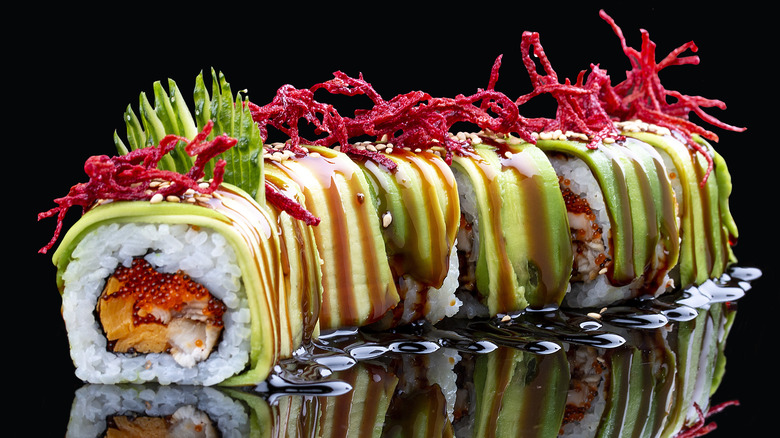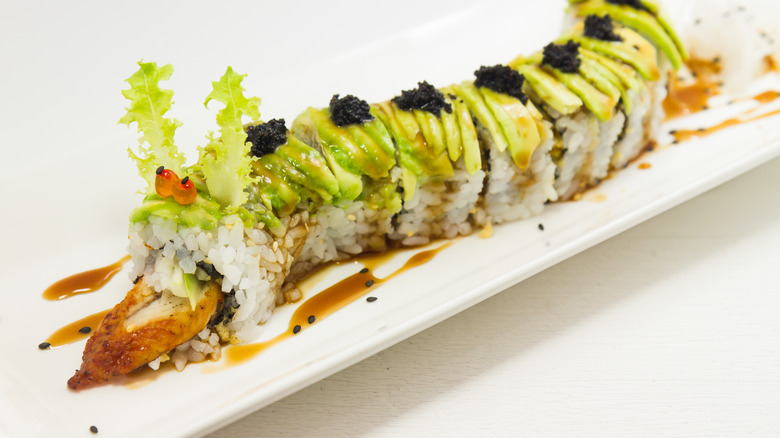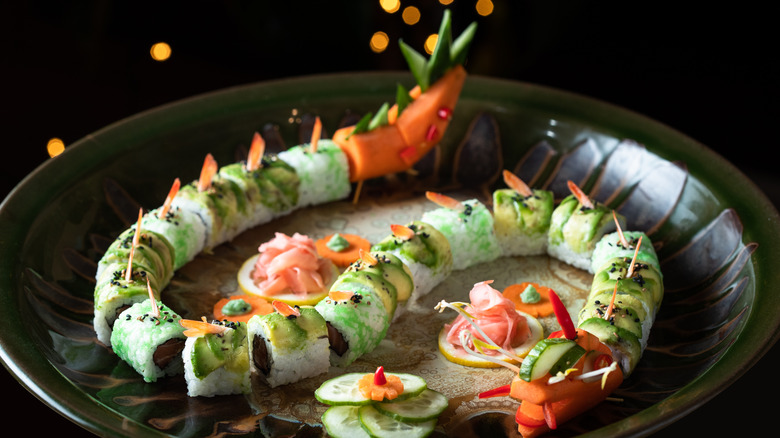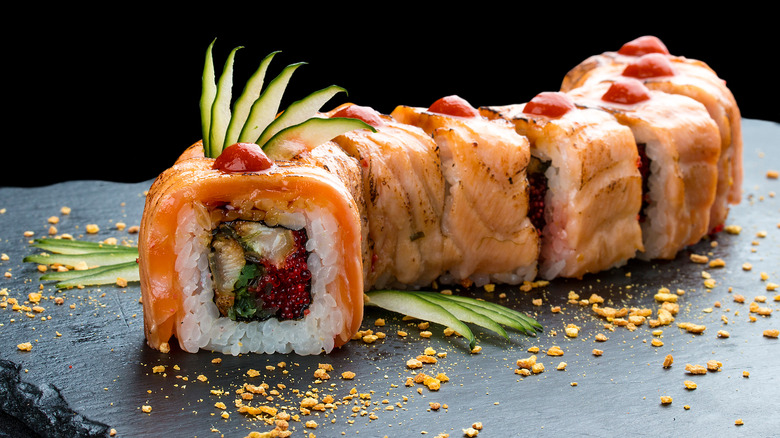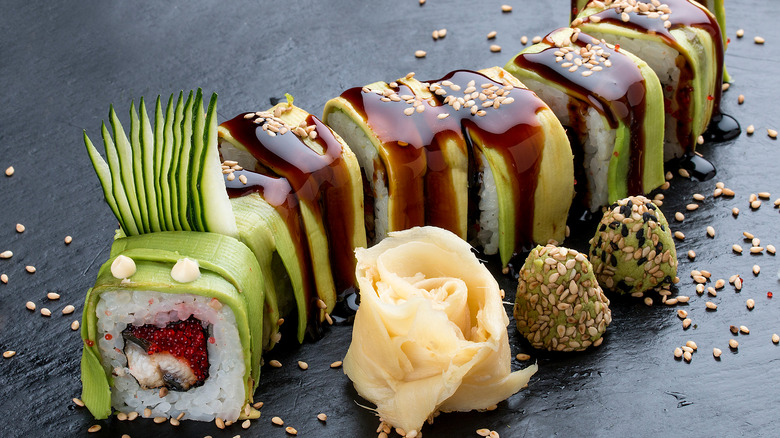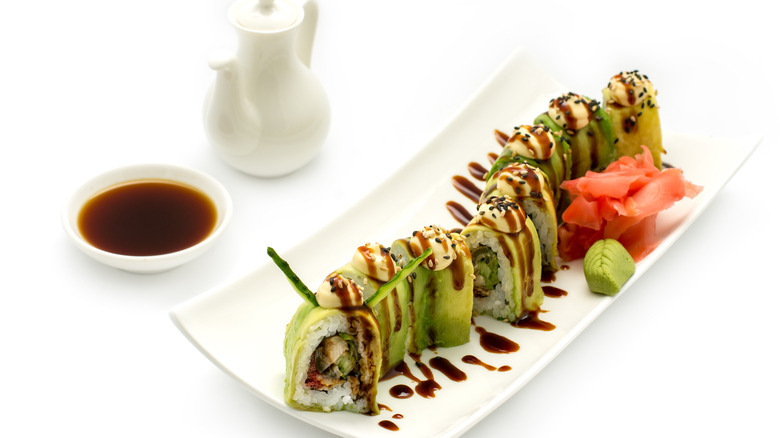Dragon Roll: What You Should Know Before Ordering
Even though sushi is most frequently associated with Japanese cuisine, its history extends further than its arrival in Japan. According to Eat-Japan, sushi can be traced back to China sometime between the fifth and third centuries BC. Other historical accounts of preserved fish are common around Southeast Asia, and the site notes that sushi first reached Japan in the eighth century. Since then, it has come a long way, diverging from its traditional forms though these continue to remain in demand along with newer experimental styles.
You can probably imagine that the sushi served nowadays across the United States is somewhat different from its original form. Besides the increase in accessibility to various ingredients, cultural influences have undoubtedly had a significant impact on sushi. Among the many fusion rolls popular for their elaborate composition is the dragon roll, a roll that is generally as aesthetically impressive as it is delicious.
Where does the dragon roll come from?
The Nibble, a webzine focusing on specialty foods, indicates that the dragon roll is an American invention. Bluefin Restaurant explains that as the concept of sushi gained popularity in the United States, chefs began to incorporate stronger flavors and multiple ingredients to accommodate the American palate. Comparatively, sushi in Japan is generally subtler, focusing more on the natural flavors of the fish, explains Sushi FAQ. While western-style sushis such as the dragon roll are embraced in the United States, Bluefin restaurant notes that they aren't as common in Japan.
Meanwhile, On the Gas, founded by an Australian living in Japan, notes that the dragon roll is enjoyed all over Japan and the world. The discrepancy might be due to assumptions that all sushi in Japan is simple and pure, whereas in reality chefs might also try to cater to other palates in touristic areas. We'll have to travel to Japan to find out!
What ingredients go into a dragon roll?
Eat-Japan explains that the word sushi refers to the vinegared rice used in the preparation, and the dragon roll certainly contains a base of rice. Although it veers away from more traditional Japanese rolls, it is still considered a maki since it is a rolled style of sushi (via Tablespoon). On the Gas explains that unlike many maki rolls that are made with the nori (seaweed) on the outside of the rice, the dragon roll is reversed and has the rice on the exterior.
Don't worry, the name doesn't come from any questionable ingredients, but from the final look of the roll which is meant to evoke a dragon. While some chefs get really artsy and design a face, others stick to a simpler look, focusing on the dragon scales.
On the food blog Delishably, the authors note that variations in the roll ingredients can be made in accordance with the chef's desires. However, Tastessence lists the main components as sushi rice, nori, grilled eel, cucumber, crab sticks, and thinly sliced ripe avocado placed on the top of the roll to create a look that mimics scales on a dragon. The outlet also mentions some versions that include crispy shrimp tempura, tobiko (flying fish roe), and tuna.
Since most versions of the dragon roll don't include raw fish, it is suitable to eat during pregnancy in case the craving strikes (via On the Gas).
Are there variations to the dragon roll?
Tastessence points out that the dragon roll is sometimes interchanged with the caterpillar roll, since the avocado exterior brings both creatures to mind. Although the ingredients remain similar, the name might vary based on whether a dragon head is built into the roll or not. As mentioned, depending on the chef making the roll, it can have some modifications. Besides the ingredients inside the roll, different versions might be topped with spicy mayo, teriyaki sauce, ponzu, unagi (eel) sauce, or Sriracha.
While each restaurant may create their own version of a dragon roll, a few that came up consistently are explained by The Kitchen Community: the classic roll, a red dragon roll, and a black dragon roll. According to the site, the classic version contains shrimp tempura, BBQ eel, cucumber, avocado, tobiko, and the usual base of sushi rice and nori. Meanwhile, the red dragon roll replaces the BBQ eel and tempura shrimp with sashimi grade tuna and fried onions, adding some Sriracha sauce for an extra red touch. The black dragon roll is more similar to a standard maki, and contains the nori leaf on the exterior, with a salmon, lime, and avocado filling.
Sushi World restaurant reveals just how experimental the roll can be with a black, white, and Atlantic version. Unlike the classic look that gives the roll its name, their dragon rolls don't have avocado on the exterior, using tuna, salmon, or albacore depending on the variation.
What's the best version of the roll?
A classic version incorporating avocado, shrimp tempura, and BBQ eel should probably be deemed the best, being one of the original interpretations. The creamy avocado, crispy shrimp, and sweet rich melt in your mouth quality of the eel blend together to create a delicious roll that is far too easy to finish in a flash. Of course, if you aren't a fan of some of the standard ingredients you might prefer a dragon roll with a twist. The many variations cater to all palates so it shouldn't be too hard to find a dragon roll to your taste.
Even though we can't confirm for sure since we've never encountered a real life dragon, we think that a dragon roll should be topped with avocado to imitate dragon scales. Not only does it look more like a dragon, but who doesn't want their sushi layered with creamy avocado?
What's the best way to eat a dragon roll?
Since the dragon roll is by no means a traditional type of sushi, rigid sushi etiquette can be waived. Sushi FAQ maintains that rolls can be eaten with your hands or with chopsticks. Since the dragon roll is usually topped with avocado, it's probably easier to use chopsticks to steer clear of the slippery texture. Even more so, the roll is often served covered in sauce which definitely makes it messier than your average sushi.
Since there are multiple components to the dragon roll, it's best to pop a whole piece into your mouth at once to avoid dropping all of the contents. As with most sushi, the dragon roll will likely be served with soy sauce, ginger, and wasabi. You can dip the roll in the soy sauce for some extra saltiness and use the ginger as a palate cleanser if you're experimenting with different rolls. Be sure to try the roll alone as well since the layered flavors and textures are already complex.
